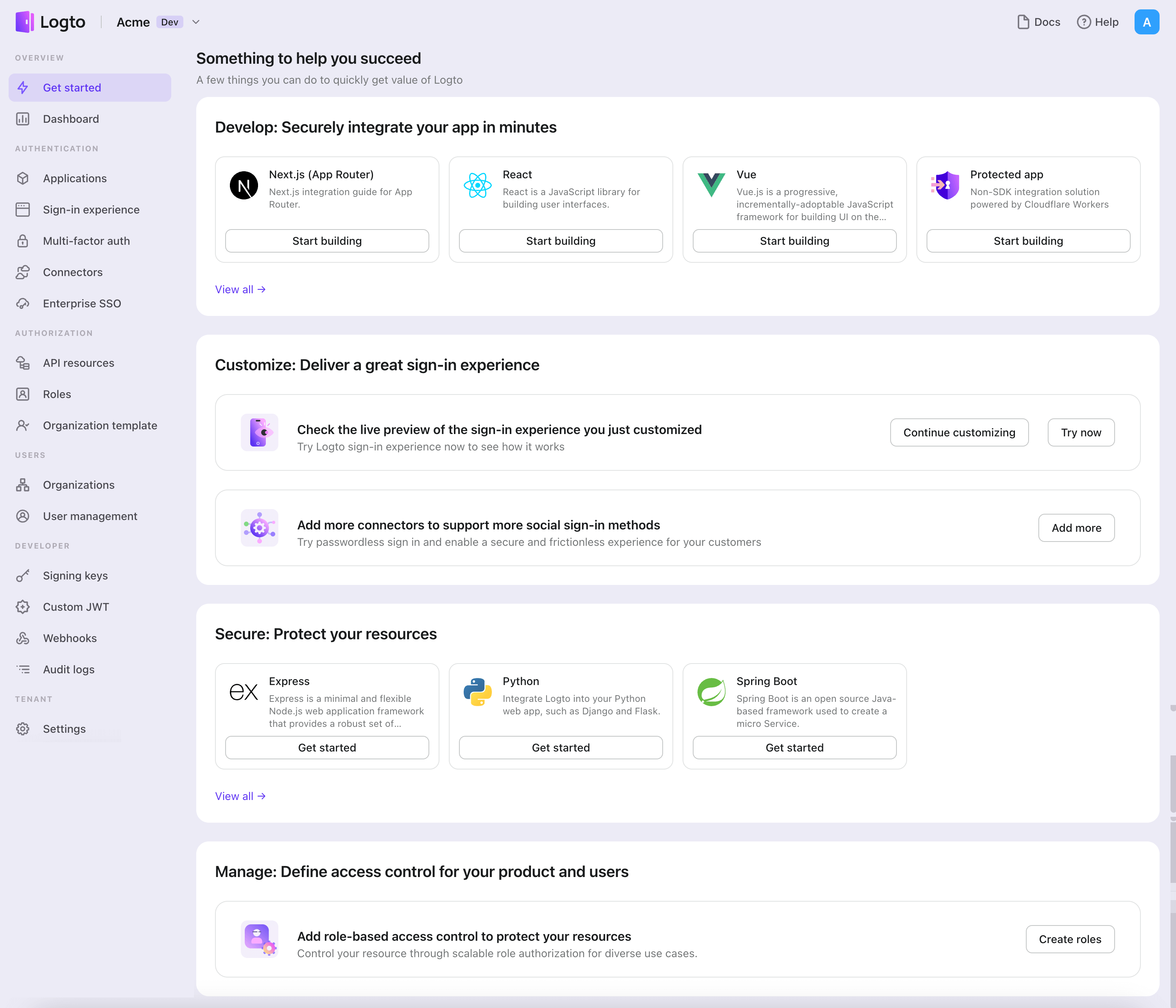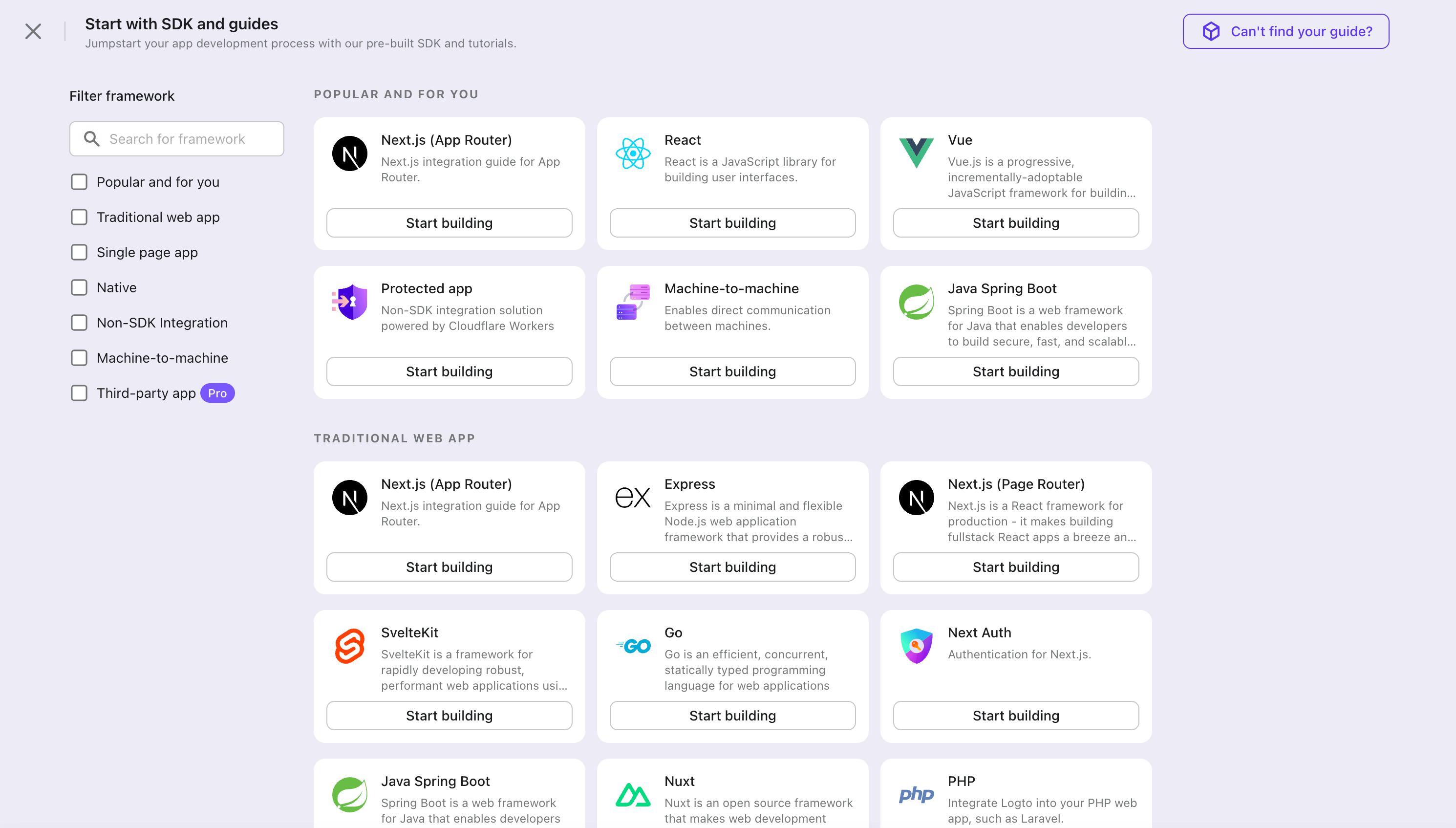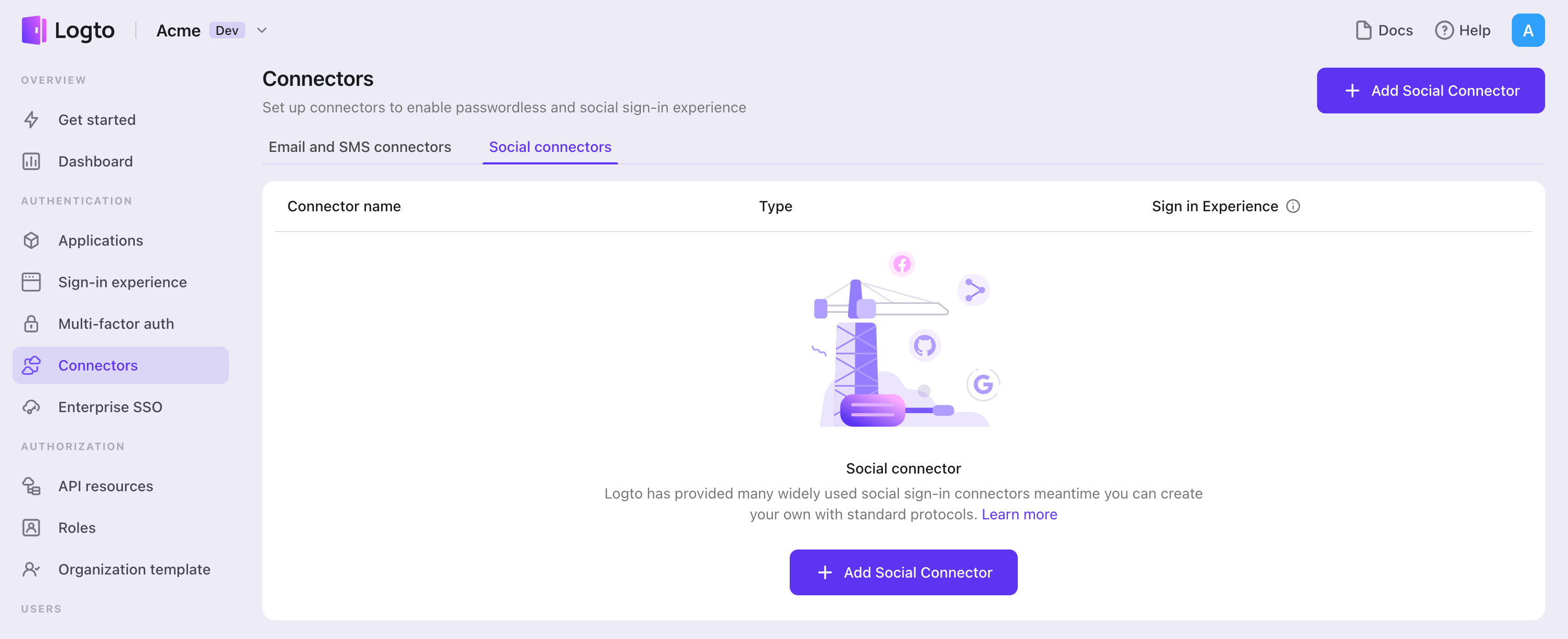Logto is an Auth0 alternative designed for modern apps and SaaS products. It offers both Cloud and Open-source services to help you quickly launch your identity and management (IAM) system. Enjoy authentication, authorization, and multi-tenant management all in one.
We recommend starting with a free development tenant on Logto Cloud. This allows you to explore all the features easily.
In this article, we will go through the steps to quickly build the OIDC sign-in experience (user authentication) with Next.js (Pages Router) and Logto.
Prerequisites
- A running Logto instance. Check out the introduction page to get started.
- Basic knowledge of Next.js (Pages Router).
- A usable OIDC account.
Create an application in Logto
Logto is based on OpenID Connect (OIDC) authentication and OAuth 2.0 authorization. It supports federated identity management across multiple applications, commonly called Single Sign-On (SSO).
To create your Traditional web application, simply follow these steps:
- Open the Logto Console. In the "Get started" section, click the "View all" link to open the application frameworks list. Alternatively, you can navigate to Logto Console > Applications, and click the "Create application" button.

- In the opening modal, click the "Traditional web" section or filter all the available "Traditional web" frameworks using the quick filter checkboxes on the left. Click the "Next.js" framework card to start creating your application.

- Enter the application name, e.g., "Bookstore," and click "Create application".
🎉 Ta-da! You just created your first application in Logto. You'll see a congrats page which includes a detailed integration guide. Follow the guide to see what the experience will be in your application.
Integrate Next.js with Logto
- The sample project is available on our SDK repository.
- The example is based on Next.js Pages Router.
Installation
Install Logto SDK via your favorite package manager:
- npm
- pnpm
- yarn
npm i @logto/nextpnpm add @logto/nextyarn add @logto/nextIntegration
Init LogtoClient
Import and initialize LogtoClient:
import LogtoClient from '@logto/next';
export const logtoClient = new LogtoClient({
appId: '<your-application-id>',
appSecret: '<your-app-secret-copied-from-console>',
endpoint: '<your-logto-endpoint>', // E.g. http://localhost:3001
baseUrl: 'http://localhost:3000',
cookieSecret: 'complex_password_at_least_32_characters_long',
cookieSecure: process.env.NODE_ENV === 'production',
});
Configure Redirect URIs
Before we dive into the details, here's a quick overview of the end-user experience. The sign-in process can be simplified as follows:
- Your app invokes the sign-in method.
- The user is redirected to the Logto sign-in page. For native apps, the system browser is opened.
- The user signs in and is redirected back to your app (configured as the redirect URI).
Regarding redirect-based sign-in
- This authentication process follows the OpenID Connect (OIDC) protocol, and Logto enforces strict security measures to protect user sign-in.
- If you have multiple apps, you can use the same identity provider (Logto). Once the user signs in to one app, Logto will automatically complete the sign-in process when the user accesses another app.
To learn more about the rationale and benefits of redirect-based sign-in, see Logto sign-in experience explained.
In the following code snippets, we assume your app is running on http://localhost:3000/.
Configure redirect URIs
Switch to the application details page of Logto Console. Add a redirect URI http://localhost:3000/api/logto/sign-in-callback.

Just like signing in, users should be redirected to Logto for signing out of the shared session. Once finished, it would be great to redirect the user back to your website. For example, add http://localhost:3000/ as the post sign-out redirect URI section.
Then click "Save" to save the changes.
Prepare API routes
Prepare API routes to connect with Logto.
Go back to your IDE/editor, use the following code to implement the API routes first:
import { logtoClient } from '../../../libraries/logto';
export default logtoClient.handleAuthRoutes();
This will create 4 routes automatically:
/api/logto/sign-in: Sign in with Logto./api/logto/sign-in-callback: Handle sign-in callback./api/logto/sign-out: Sign out with Logto./api/logto/user: Check if user is authenticated with Logto, if yes, return user info.
Implement sign-in and sign-out
We have prepared the API routes, now let's implement the sign-in and sign-out buttons in your home page. We need to redirect the user to the sign-in or sign-out route when needed. To help with this, use useSWR to fetch authentication status from /api/logto/user.
Check this guide to learn more about useSWR.
import { type LogtoContext } from '@logto/next';
import useSWR from 'swr';
const Home = () => {
const { data } = useSWR<LogtoContext>('/api/logto/user');
return (
<nav>
{data?.isAuthenticated ? (
<p>
Hello, {data.claims?.sub},
<button
onClick={() => {
window.location.assign('/api/logto/sign-out');
}}
>
Sign Out
</button>
</p>
) : (
<p>
<button
onClick={() => {
window.location.assign('/api/logto/sign-in');
}}
>
Sign In
</button>
</p>
)}
</nav>
);
};
export default Home;
Checkpoint: Test your application
Now, you can test your application:
- Run your application, you will see the sign-in button.
- Click the sign-in button, the SDK will init the sign-in process and redirect you to the Logto sign-in page.
- After you signed in, you will be redirected back to your application and see the sign-out button.
- Click the sign-out button to clear token storage and sign out.
Add OIDC connector
To enable quick sign-in and improve user conversion, connect with Next.js as an identity provider. The Logto social connector helps you establish this connection in minutes by allowing several parameter inputs.
To add a social connector, simply follow these steps:
- Navigate to Console > Connectors > Social Connectors.
- Click "Add social connector" and select "OIDC".
- Follow the README guide and complete required fields and customize settings.

If you are following the in-place Connector guide, you can skip the next section.
Set up Standard OIDC app
Create your OIDC app
When you open this page, we believe you already know which social identity provider you want to connect to. The first thing to do is to confirm that the identity provider supports the OIDC protocol, which is a prerequisite for configuring a valid connector. Then, follow the identity provider's instructions to register and create the relevant app for OIDC authorization.
Configure your connector
We ONLY support "Authorization Code" grant type for security consideration and it can perfectly fit Logto's scenario.
clientId and clientSecret can be found at your OIDC apps details page.
clientId: The client ID is a unique identifier that identifies the client application during registration with the authorization server. This ID is used by the authorization server to verify the identity of the client application and to associate any authorized access tokens with that specific client application.
clientSecret: The client secret is a confidential key that is issued to the client application by the authorization server during registration. The client application uses this secret key to authenticate itself with the authorization server when requesting access tokens. The client secret is considered confidential information and should be kept secure at all times.
tokenEndpointAuthMethod: The token endpoint authentication method is used by the client application to authenticate itself with the authorization server when requesting access tokens. To discover supported methods, consult the token_endpoint_auth_methods_supported field available at the OAuth 2.0 service provider’s OpenID Connect discovery endpoint, or refer to the relevant documentation provided by the OAuth 2.0 service provider.
clientSecretJwtSigningAlgorithm (Optional): Only required when tokenEndpointAuthMethod is client_secret_jwt. The client secret JWT signing algorithm is used by the client application to sign the JWT that is sent to the authorization server during the token request.
scope: The scope parameter is used to specify the set of resources and permissions that the client application is requesting access to. The scope parameter is typically defined as a space-separated list of values that represent specific permissions. For example, a scope value of "read write" might indicate that the client application is requesting read and write access to a user's data.
You are expected to find authorizationEndpoint, tokenEndpoint, jwksUri and issuer as OpenID Provider's configuration information. They should be available in social vendor's documentation.
authenticationEndpoint: This endpoint is used to initiate the authentication process. The authentication process typically involves the user logging in and granting authorization for the client application to access their resources.
tokenEndpoint: This endpoint is used by the client application to obtain an id token that can be used to access the requested resources. The client application typically sends a request to the token endpoint with a grant type and authorization code to receive an id token.
jwksUri: This is the URL endpoint where the JSON Web Key Set (JWKS) of the social identity provider (IdP for short) can be obtained. The JWKS is a set of cryptographic keys that the IdP uses to sign and verify JSON Web Tokens (JWTs) that are issued during the authentication process. The jwksUri is used by the relying party (RP) to obtain the public keys used by the IdP to sign the JWTs, so the RP can verify the authenticity and integrity of the JWTs received from the IdP.
issuer: This is the unique identifier of the IdP that is used by the RP to verify the JWTs received from the IdP. It is included in the JWTs as the iss claim (Id token is always a JWT). The issuer value should match the URL of the IdP's authorization server, and it should be a URI that the RP trusts. When the RP receives a JWT, it checks the iss claim to ensure that it was issued by a trusted IdP, and that the JWT is intended for use with the RP.
Together, jwksUri and issuer provide a secure mechanism for the RP to verify the identity of the end-user during the authentication process. By using the public keys obtained from the jwksUri, the RP can verify the authenticity and integrity of the JWTs issued by the IdP. The issuer value ensures that the RP only accepts JWTs that were issued by a trusted IdP, and that the JWTs are intended for use with the RP.
Since an authentication request is always required, an authRequestOptionalConfig is provided to wrap all optional configs, you can find details on OIDC Authentication Request. You may also find that nonce is missing in this config. Since nonce should identical for each request, we put the generation of nonce in code implementation. So do not worry about it! Previously mentioned jwksUri and issuer are also included in idTokenVerificationConfig.
You may be curious as to why a standard OIDC protocol supports both the implicit and hybrid flows, yet the Logto connector only supports the authorization flow. It has been determined that the implicit and hybrid flows are less secure than the authorization flow. Due to Logto's focus on security, it only supports the authorization flow for the highest level of security for its users, despite its slightly less convenient nature.
responseType and grantType can ONLY be FIXED values with "Authorization Code" flow, so we make them optional and default values will be automatically filled.
For all flow types, we provided an OPTIONAL customConfig key to put your customize parameters.
Each social identity provider could have their own variant on OIDC standard protocol. If your desired social identity provider strictly stick to OIDC standard protocol, the you do not need to care about customConfig.
Config types
| Name | Type | Required |
|---|---|---|
| scope | string | True |
| clientId | string | True |
| clientSecret | string | True |
| authorizationEndpoint | string | True |
| tokenEndpoint | string | True |
| idTokenVerificationConfig | IdTokenVerificationConfig | True |
| authRequestOptionalConfig | AuthRequestOptionalConfig | False |
| customConfig | Record<string, string> | False |
| AuthRequestOptionalConfig properties | Type | Required |
|---|---|---|
| responseType | string | False |
| tokenEndpoint | string | False |
| responseMode | string | False |
| display | string | False |
| prompt | string | False |
| maxAge | string | False |
| uiLocales | string | False |
| idTokenHint | string | False |
| loginHint | string | False |
| acrValues | string | False |
| IdTokenVerificationConfig properties | Type | Required |
|---|---|---|
| jwksUri | string | True |
| issuer | string | string[] | False |
| audience | string | string[] | False |
| algorithms | string[] | False |
| clockTolerance | string | number | False |
| crit | Record<string, string | boolean> | False |
| currentDate | Date | False |
| maxTokenAge | string | number | False |
| subject | string | False |
| typ | string | False |
See here to find more details about IdTokenVerificationConfig.
General settings
Here are some general settings that won't block the connection to your identity provider but may affect the end-user authentication experience.
Social button name and logo
If you want to display a social button on your login page, you can set the name and logo (dark mode and light mode) of the social identity provider. This will help users recognize the social login option.
Identity provider name
Each social connector has a unique Identity Provider (IdP) name to differentiate user identities. While common connectors use a fixed IdP name, custom connectors require a unique value. Learn more about IdP names for more details.
Sync profile information
In the OIDC connector, you can set the policy for syncing profile information, such as user names and avatars. Choose from:
- Only sync at sign-up: Profile info is fetched once when the user first signs in.
- Always sync at sign-in: Profile info is updated every time the user signs in.
Store tokens to access third-party APIs (Optional)
If you want to access the Identity Provider's APIs and perform actions with user authorization (whether via social sign-in or account linking), Logto needs to get specific API scopes and store tokens.
- Add the required scopes in the scope field following the instructions above
- Enable Store tokens for persistent API access in the Logto OIDC connector. Logto will securely store access tokens in the Secret Vault.
- For standard OAuth/OIDC identity providers, the
offline_accessscope must be included to obtain a refresh token, preventing repeated user consent prompts.
Keep your client secret secure and never expose it in client-side code. If compromised, generate a new one immediately in your identity provider's app settings.
Utilize the OIDC connector
Once you've created an OIDC connector and connected it to your identity provider, you can incorporate it into your end-user flows. Choose the options that match your needs:
Enable social sign-in button
- In Logto Console, go to Sign-in experience > Sign-up and sign-in.
- Add the OIDC connector under Social sign-in section to let users authenticate with your identity provider.
Learn more about social sign-in experience.
Link or unlink a social account
Use the Account API to build a custom Account Center in your app that lets signed-in users link or unlink their social accounts. Follow the Account API tutorial
It's allowed to enable the OIDC connector only for account linking and API access, without enabling it for social sign-in.
Access identity provider APIs and perform actions
Your application can retrieve stored access tokens from the Secret Vault to call your identity provider's APIs and automate backend tasks. The specific capabilities depend on your identity provider and the scopes you've requested. Refer to the guide on retrieving stored tokens for API access.
Manage user's social identity
After a user links their social account, admins can manage that connection in the Logto Console:
- Navigate to Logto console > User management and open the user's profile.
- Under Social connections, locate the identity provider item and click Manage.
- On this page, admins can manage the user's social connection, see all profile information granted and synced from their social account, and check the access token status.
A few Identity Provider access token response does not include the specific scope information, so Logto cannot directly display the list of permissions granted by the user. However, as long as the user has consented to the requested scopes during authorization, your application will have the corresponding permissions when accessing the OIDC API.
Save your configuration
Double check you have filled out necessary values in the Logto connector configuration area. Click "Save and Done" (or "Save changes") and the OIDC connector should be available now.
Enable OIDC connector in Sign-in Experience
Once you create a social connector successfully, you can enable it as a "Continue with OIDC" button in Sign-in Experience.
- Navigate to Console > Sign-in experience > Sign-up and sign-in.
- (Optional) Choose "Not applicable" for sign-up identifier if you need social login only.
- Add configured OIDC connector to the "Social sign-in" section.

Testing and Validation
Return to your Next.js (Pages Router) app. You should now be able to sign in with OIDC. Enjoy!
Further readings
End-user flows: Logto provides a out-of-the-box authentication flows including MFA and enterprise SSO, along with powerful APIs for flexible implementation of account settings, security verification, and multi-tenant experience.
Authorization: Authorization defines the actions a user can do or resources they can access after being authenticated. Explore how to protect your API for native and single-page applications and implement Role-based Access Control (RBAC).
Organizations: Particularly effective in multi-tenant SaaS and B2B apps, the organization feature enable tenant creation, member management, organization-level RBAC, and just-in-time-provisioning.
Customer IAM series Our serial blog posts about Customer (or Consumer) Identity and Access Management, from 101 to advanced topics and beyond.